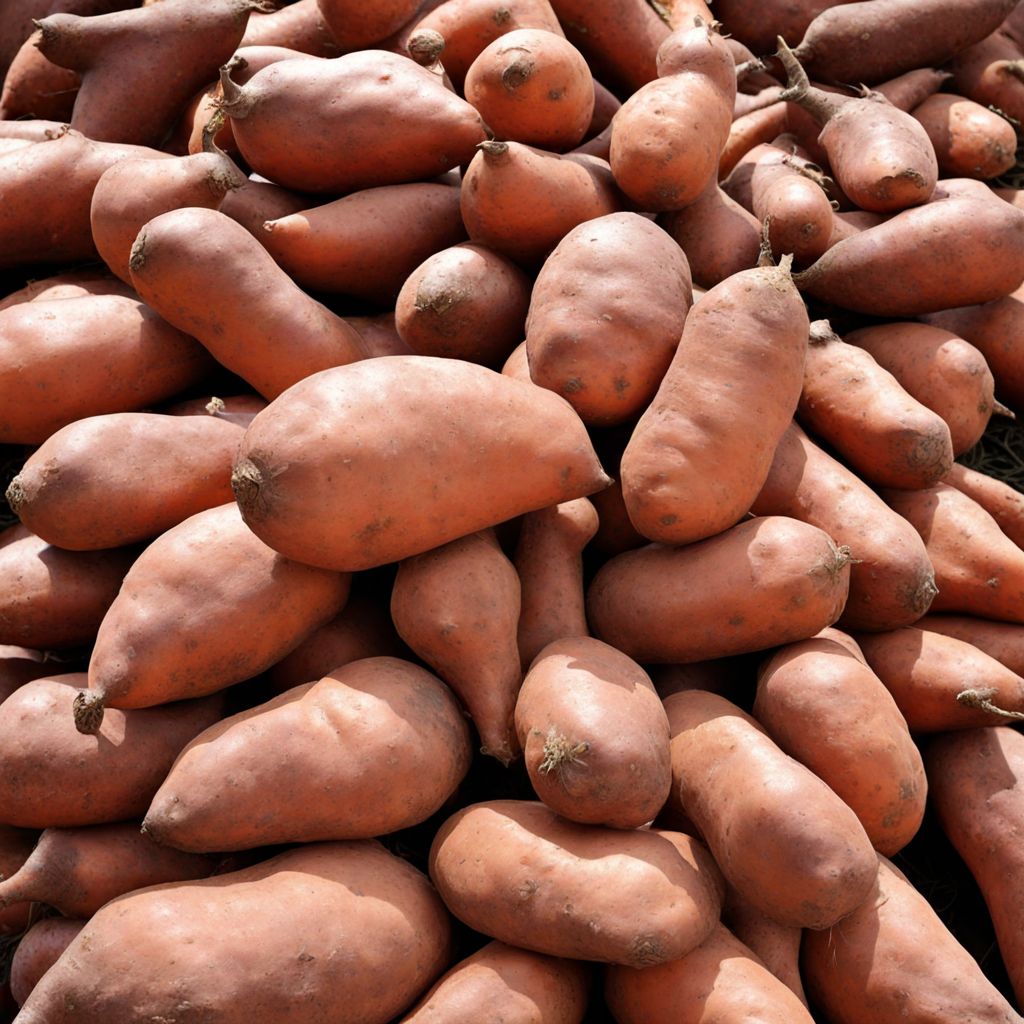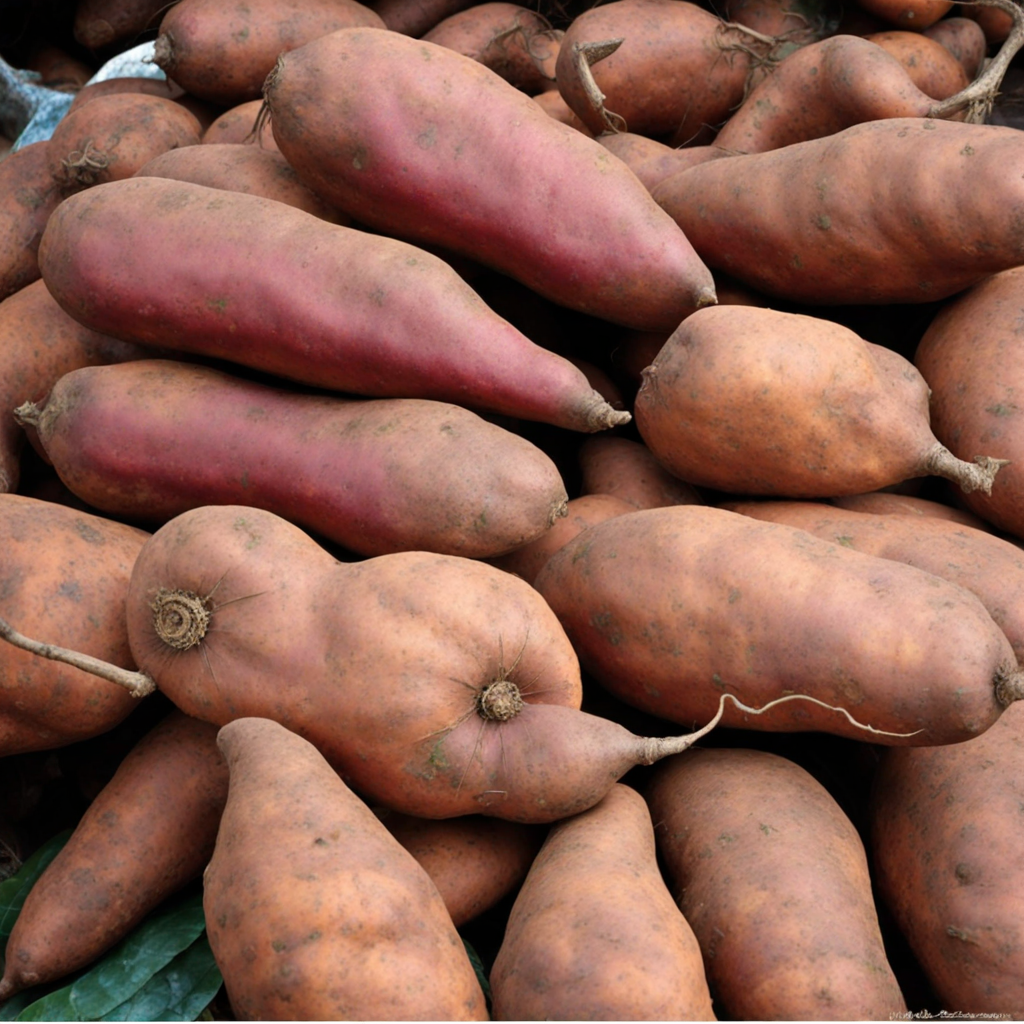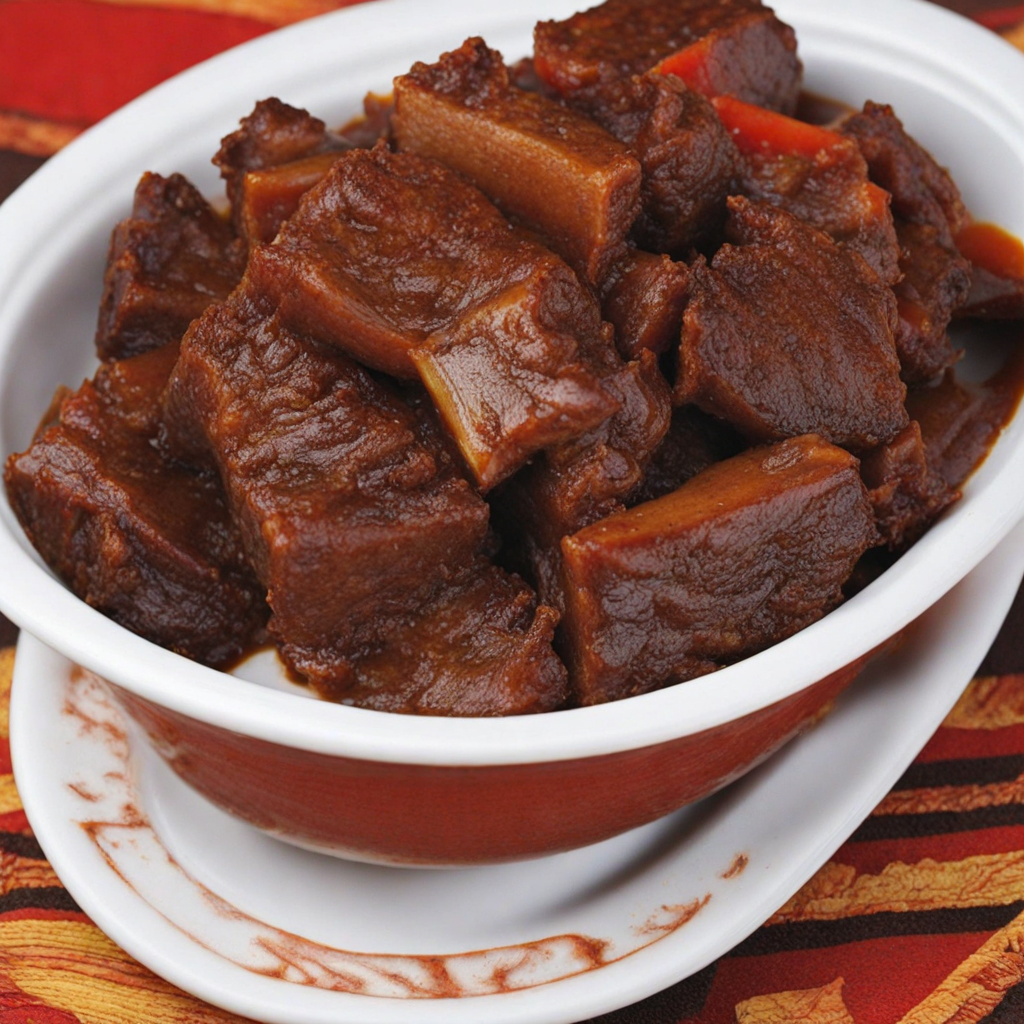Sweet Potato
Sweet potato, known as "bake" in Eswatini, is a staple food that embodies the country's rich agricultural heritage. This vibrant root vegetable is typically characterized by its creamy texture and earthy sweetness, making it a versatile ingredient in various dishes. The sweet potatoes are often roasted, boiled, or steamed, enhancing their natural flavors while providing a comforting and nutritious addition to the local diet. Their bright orange hue is not only visually appealing but also signifies the abundance of beta-carotene, which is beneficial for health. In Eswatini, sweet potatoes are frequently enjoyed as a side dish, accompanying protein-rich foods such as meat or beans. They can be mashed and seasoned with local spices, or served as wedges that are lightly fried or baked to a crispy perfection. The subtle sweetness pairs beautifully with savory elements, creating a delightful contrast that intrigues the palate. Additionally, sweet potatoes can be used in traditional dishes such as 'umkhukhu' – a type of porridge made with sweet potato flour, showcasing their versatility beyond just a side dish. As you explore the flavors of Eswatini, sweet potatoes also find their way into desserts, where they are transformed into pies or cakes, often flavored with cinnamon and nutmeg. This unique twist highlights the sweet potato's ability to straddle the line between savory and sweet, inviting those seeking a new taste experience to indulge in its richness. Whether enjoyed in a traditional meal or as a sweet treat, sweet potatoes from Eswatini offer a warm, comforting, and nutritious journey into the heart of the country's culinary traditions.
How It Became This Dish
The History of Likotikoti: A Culinary Treasure from Eswatini Introduction Likotikoti, a traditional dish deeply rooted in the cultural fabric of Eswatini (formerly known as Swaziland), offers a unique insight into the culinary practices and communal life of the Swazi people. This delightful dish, often made from a combination of ingredients including maize meal, beans, and occasionally meat, showcases the resourcefulness and agricultural heritage of the Swazi nation. Through its history, Likotikoti has evolved, reflecting the changes in society, economy, and even political dynamics within Eswatini. Origins of Likotikoti The origins of Likotikoti can be traced back to ancient agrarian societies in Southern Africa. The Swazi people, like many other ethnic groups in the region, have relied on maize as a staple food, which was introduced to the continent from the Americas during the Columbian Exchange in the late 15th century. Maize quickly adapted to the local climate and became a fundamental crop for sustenance. Combining maize meal with beans, a rich source of protein, Likotikoti emerged as a hearty dish that not only nourished but also brought communities together. The preparation of Likotikoti often involved communal cooking, where families and neighbors would gather, reinforcing social bonds and cultural traditions. This aspect of communal cooking is an essential part of Swazi culture, emphasizing the values of sharing and cooperation. As maize and beans became staples, the dish began to evolve. Variations emerged based on regional availability of ingredients, the influence of neighboring cultures, and the changing lifestyles of the Swazi people. For example, in more rural areas where livestock was prevalent, Likotikoti might be enriched with meat, while in urban settings, it could be prepared with an emphasis on convenience and speed, utilizing canned beans or pre-cooked maize meal. Cultural Significance Likotikoti is not merely a dish; it is a symbol of Swazi identity and heritage. In Eswatini, food carries profound meanings, often linked to ceremonies, rituals, and communal gatherings. Likotikoti is frequently served during traditional events, weddings, and festivals, embodying the spirit of celebration and unity. At these gatherings, the dish serves as a centerpiece, showcasing the importance of hospitality and the sharing of resources. Moreover, Likotikoti has cultural significance in the context of gender roles and family dynamics. Traditionally, women have been the primary custodians of culinary knowledge, passing down recipes and cooking techniques through generations. The preparation of Likotikoti often involves intricate knowledge of timing, flavor combinations, and presentation, and it is considered a rite of passage for young girls to learn how to prepare this dish. This passing down of culinary skills reinforces the matrilineal aspects of Swazi society, where women play a crucial role in maintaining cultural continuity. Development Over Time As Eswatini transitioned through various historical phases, including colonization and independence, Likotikoti reflected the changing socio-political landscape. The British colonial period introduced new agricultural practices, trade routes, and even foreign ingredients, influencing how Likotikoti was prepared and consumed. Canned goods, for example, became more accessible, allowing urban dwellers to adapt traditional recipes to fit their fast-paced lifestyles. The rise of globalization has also impacted the way Likotikoti is perceived and prepared. With the influx of international cuisine and culinary trends, some younger generations may view traditional dishes like Likotikoti as outdated or less appealing. However, there has been a resurgence in interest in indigenous foods, driven by a growing awareness of the importance of food sovereignty, health, and environmental sustainability. Many young Swazi chefs and food enthusiasts are now experimenting with Likotikoti, infusing it with contemporary flavors or presenting it with a modern twist, thus ensuring its survival amidst changing culinary landscapes. Additionally, the expansion of tourism in Eswatini has led to a renewed appreciation for traditional dishes, including Likotikoti. Visitors to the kingdom are increasingly seeking authentic culinary experiences, prompting local chefs to highlight traditional recipes in their offerings. This has created a commercial incentive to preserve and innovate upon Likotikoti, ensuring that it remains relevant while still honoring its roots. Likotikoti in Contemporary Eswatini In contemporary Eswatini, Likotikoti continues to hold its place as a beloved dish, embodying the essence of Swazi hospitality and culinary tradition. It represents resilience in the face of modern challenges, such as economic fluctuations and the impacts of climate change on agriculture. With the increasing push for sustainable agricultural practices, many Swazi farmers are returning to traditional crops, ensuring the availability of ingredients for Likotikoti while promoting biodiversity and food security. Moreover, community initiatives aimed at preserving culinary heritage have emerged, encouraging younger generations to engage with traditional cooking practices. Workshops, cooking classes, and cultural festivals often feature Likotikoti as a highlight, allowing participants to learn the dish's history and preparation techniques, thus fostering a deeper connection to their cultural identity. Conclusion Likotikoti is more than just a meal; it is a narrative that encapsulates the history, culture, and resilience of the Swazi people. From its humble beginnings as a staple food to its status as a symbol of community and cultural pride, Likotikoti has navigated the complexities of time, adapting to societal changes while remaining true to its essence. As Eswatini continues to evolve, Likotikoti stands as a testament to the power of food in uniting people and preserving cultural heritage. The future of Likotikoti looks promising, with new generations eager to embrace their culinary legacy while innovating and redefining what this cherished dish means in a modern context.
You may like
Discover local flavors from Eswatini







